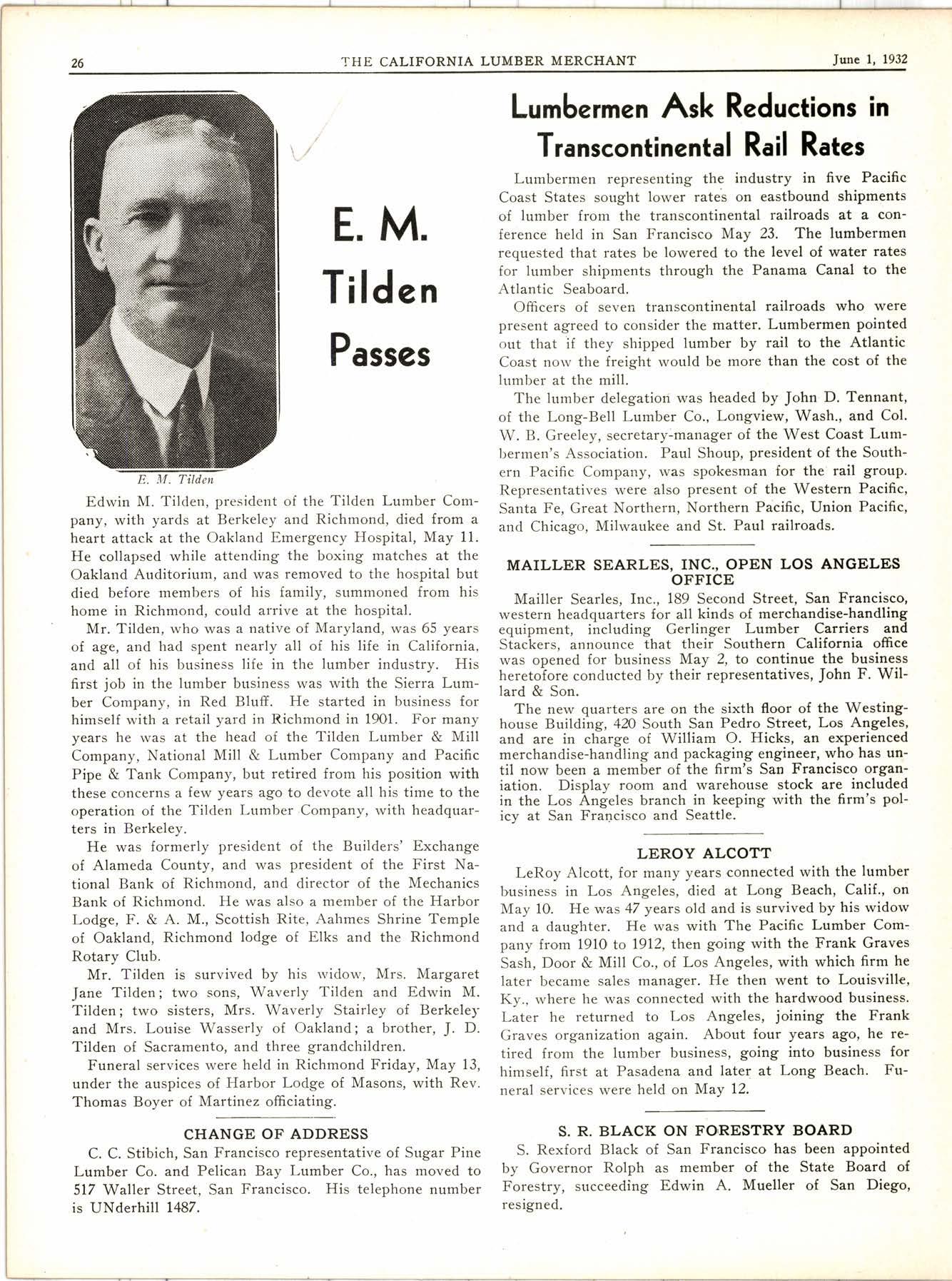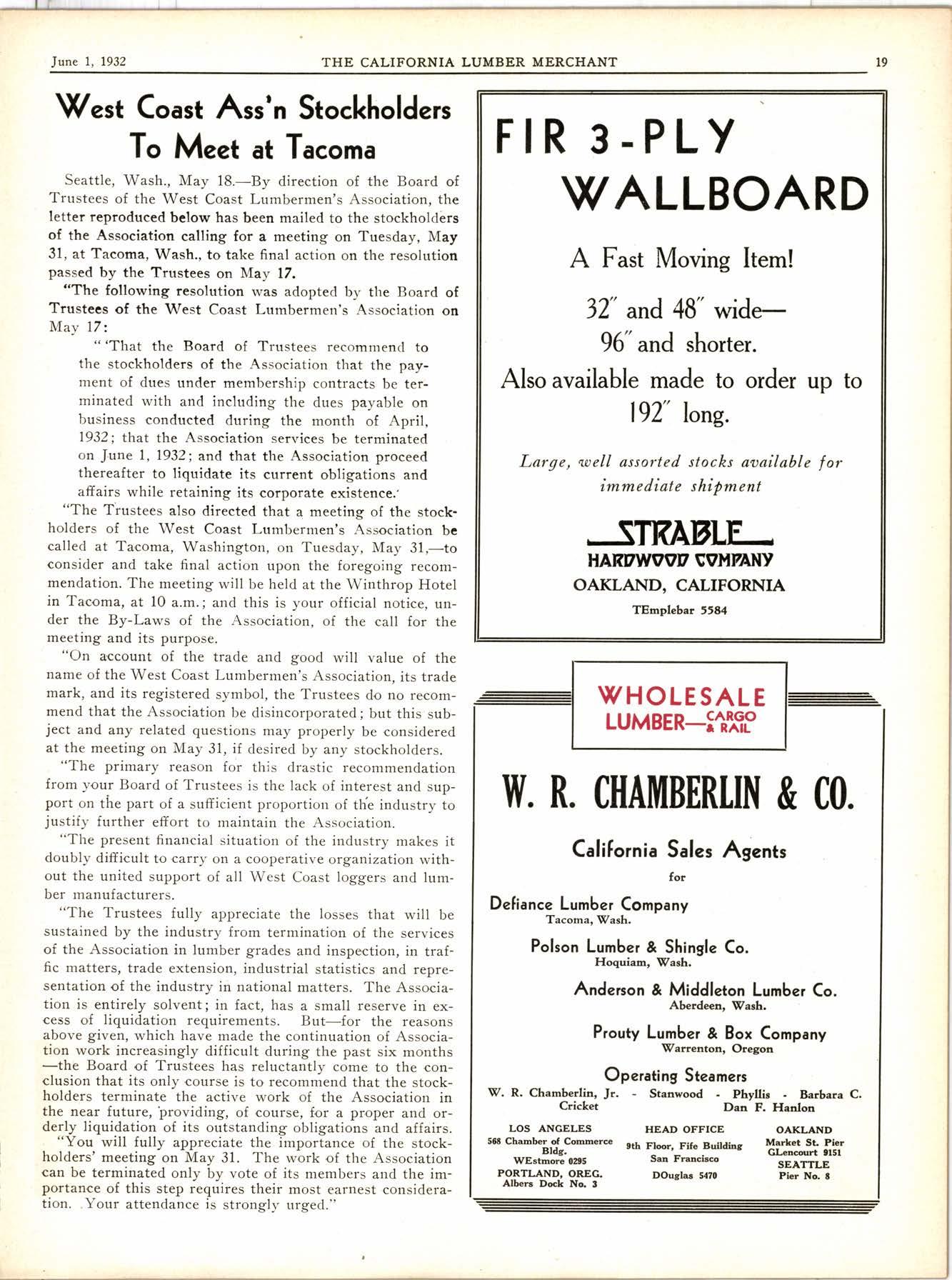
4 minute read
\(/hat The Lumber Industry Needs
(Continued from Page 11) toward whi,ch private timber owners should cooperate to the fullest possible extent.
It is impossible to adequately describe the principle of sustained yield forest management in this paper. Suffice it to say briefly that it consists of a form of managing such forest lands as may comprise an economic unit in such manner as to protect and reprodu,ce the forests therein, and at the same time harvest the trees at a sufficiently moderate annual rate as to permit new growth to repla'ce the timber cut, thus giving a continuous, permanent, and regular output of forest products from the area. The principle. except for the items of prote,ction and reproduction, is not unlike that of unit operation of an oil pool.
This form of management will accornplish the utmost toward community maintenance, stabilization of employment, and provide most effectively for the national timber supply. In doing all this it r,vill provide an adequate and effective step torvard the elimination of overproduction.
The adoption of a feasible widespread program of sustained yield forest management in the western states involves cooperative timber management in forest units in which substantial quantities of both private and publi,c timber occur. It also involves the setting up of sound, long time policies for the protection and ultimate orderly disposal of all public timber and for the protection and acquisition of such private forest land as cannot be proper- ly managed in private ownership. There is also involved the application of selective logging, rvhich has the effect of placing the whole enterprise on a more sound economic basis. Frequently, or usually, mergers of private properties are essential or will greatly prornote the effective establishment of sustained yield units.
The subject is compiicated and requires study, and endorsement by private land owners. Its inauguration presupposes a willingness on the part of operators to find the proper application of selective logging where possible, ancl most of all recognition by public land owners of the necessities, and a willingness to deal justly r,r'ith responsible operators.
Obviously this program requires mutual co,nfidence and fair dealing and can only ,come out of cooperative effort. Its results I'r,ill benefit all groups inter-related within the lumber industry.
The greatei' part of my paper has now been read and I have told you only of those things which others must do for us or must help us do. To talk more about getting help and less about helping ourselves probably reflects the typi'cal American attitude today. But at least I hope we can agree upon the kind of help we need.
From now on I want to talk about helping ourselves.
The equally important ,corollary of controlled production is market extension. The lumber industry has been living largely on the momentum resulting from its long period of service. Its matketing methods are as out of date as the horse and buggy. The prices at which its product is sold are not made by the producers. Its trade extension work as an industry has hardly scratched the surface. Now that the industry is so poor it is just so much harder to realize that more money must be spent in order to control its sales and promote its product against the ever increasing field of substitutes. 'We are becoming alive to these facts, but I do not see how they can be effectively met unless our trade association activities, wherein matters of mutual in- terest should be centered, are given adequate financial support no matter how much it hurts, and more than that, active thought and direction by all lumbermen.
A 'catalog of our needs cannot but bring home to everyone the fact that what we do for our own selfish company interes,ts has turned out to be absolutely inadequate. We must recognize that however unwieldy our trade dssociation organizations, the solution to our problems lies in these cooperative agencies. Our attention mus,t be to a very much greater extent than ever before, given to those matters which con,cern us all, and not those solely concerning our own bailiwick.
D.uring the past generation we have seen individual companies improve greatly in efficiency of industrial processes and internal management, but very little improvement is eviden,ced in those groups of companies which,constitute an industry, toward'the effe,ctive management of the industry. Still less progress evidently has been made toward effective cooperation between groups of industries in solving their common problems.
In the lumber industry, and no doubt in others also, we must recognize the fact that individual companies can attain real success onlv to the extent that their industry as a whole is soundly managed, and that each company, as a responsible unit, must support those activities which are essential to the common good of the industry. I think that means membership in and full support of the trade association whi,ch is the nearest feasible approach to an orderly "government" or industry. That membership and suppoit must find ways of putting that association in a poiilion where it can much more effectively function as an orderly "government." Consequently it devolves upon members t-o actively parti,cipate in the thought behind association prog'rams, and means of effectively putting those programs into or,ce,
Given strong association government in the lumber indus,try and others, many points of contact exist between industries. One problem of this character, upon the solution of which possibly the maintenance of our present economic system depends, is that of maintaining stable employment.
Another is that, already mentioned, joint responsibility of all of us and our industries to be'critical and helpful in analysis of government economy and tax revision. -
While all lumber markets need maintenan.ce work, it seems. especially necessary that the industry help the construction field to the end that lumber can go into place with the efficiency that do other materials. Another large lumber market needing help much in excess of its receipls is the box field. I mention these two as indicative of lhe necessity o,f research work by the industry in order to apply intelligent trade extension help.
We need expanded research and trade extension work. We need lower long haul railroad rates. We need an adequate lumber import tax. We need revision or a new interpretation of our. anti-trust laws. We need to greatly strengthen our distribution facilities. We need a vi6ta tai on timb.er. We need sustained yield forest management and stronger trade associations.
While this list of needs is imposing, it does not seem to me impossible_of attainment, can the industry unite to promote them and solicit the aid of its friends and partner! as necessary.










